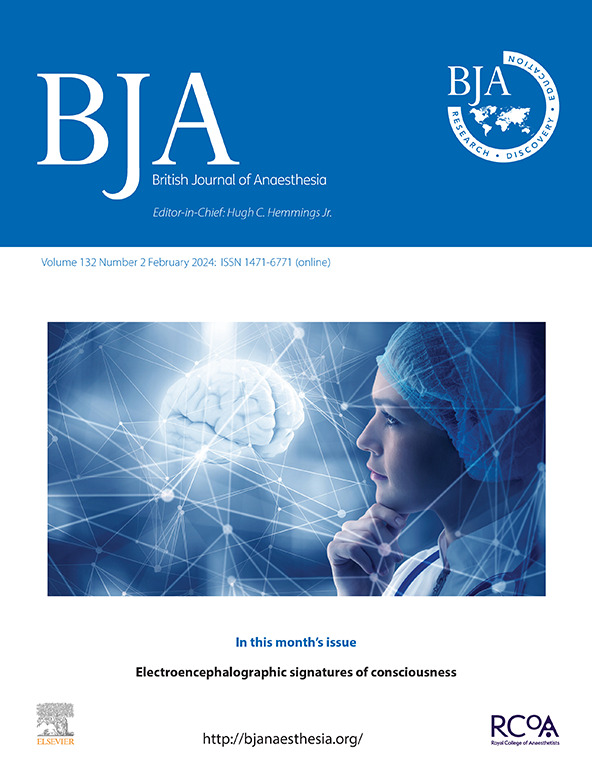Are adults with chronic pain more likely to develop hypertension than adults without chronic pain? A systematic review and meta-analysis.
IF 9.1
1区 医学
Q1 ANESTHESIOLOGY
引用次数: 0
Abstract
BACKGROUND An association between persistent pain and blood pressure is increasingly recognised but is not fully understood. In this systematic review, we aimed to establish whether chronic pain (CP) is associated with a diagnosis of hypertension (HTN). METHODS After prospective registration (PROSPERO ID: CRD42025629486), we searched six databases from inception until January 8, 2025, for studies investigating the association between CP and HTN. Title and abstract screening, full-text review, data extraction, and risk of bias assessment were performed by two independent reviewers. Study quality assessment used the Risk of Bias In Non-randomised Studies of Exposures (ROBINS-E) tool. Meta-analysis was conducted using a random effects model. RESULTS From 7973 records, we identified 23 eligible studies for inclusion, of which 20 provided suitable data for meta-analysis (total participants n=1 594 264). The pooled odds ratio for HTN in people with CP compared with controls was 1.66 (95% confidence interval [CI] 1.28-2.15) with high inter-study heterogeneity (I2=99.8%, Cochran Q=10 132, p<0.001). For specific pain conditions, the pooled odds ratio for HTN was 1.38 (95% CI 1.20-1.58, n = 374 234, heterogeneity: I2=65.1%, Cochran Q=14.34, p=0.014) in people with chronic, widespread pain, and 1.56 (95% CI 1.37-1.79, n=477 681, heterogeneity: I2=0%, Cochran Q=0.17, p=0.92) in people with chronic headache. There was no association between HTN and musculoskeletal pain, lower back pain, or gender. CONCLUSIONS In line with a growing body of evidence in this field, this systematic review and meta-analysis confirms an association between chest pain and hypertension. Further research is warranted to understand this association and elucidate any mediating factors. SYSTEMATIC REVIEW PROTOCOL PROSPERO (CRD42025629486).有慢性疼痛的成年人比没有慢性疼痛的成年人更容易患高血压吗?系统回顾和荟萃分析。
背景:持续疼痛和血压之间的联系已被越来越多地认识到,但尚未完全了解。在这篇系统综述中,我们旨在确定慢性疼痛(CP)是否与高血压(HTN)的诊断相关。方法前瞻性注册(PROSPERO ID: CRD42025629486)后,我们检索了6个数据库,从建立到2025年1月8日,研究CP和HTN之间的关系。标题和摘要筛选、全文审查、数据提取和偏倚风险评估由两名独立审稿人进行。研究质量评估使用了非随机暴露研究的偏倚风险(ROBINS-E)工具。采用随机效应模型进行meta分析。结果从7973条记录中,我们确定了23项符合纳入条件的研究,其中20项提供了适合进行meta分析的数据(总参与者n=1 594 264)。与对照组相比,CP患者HTN的合并优势比为1.66(95%可信区间[CI] 1.28-2.15),研究间异质性较高(I2=99.8%, Cochran Q=10 132, p<0.001)。对于特定疼痛情况,慢性广泛性疼痛患者HTN的合并优势比为1.38 (95% CI 1.20-1.58, n= 374234,异质性:I2=65.1%,科克伦Q=14.34, p=0.014),慢性头痛患者HTN的合并优势比为1.56 (95% CI 1.37-1.79, n= 477681,异质性:I2=0%,科克伦Q=0.17, p=0.92)。HTN与肌肉骨骼疼痛、腰痛或性别之间没有关联。结论:与该领域越来越多的证据一致,本系统综述和荟萃分析证实了胸痛和高血压之间的关联。进一步的研究是必要的,以了解这种联系,并阐明任何中介因素。系统评价协议prospero (crd42025629486)。
本文章由计算机程序翻译,如有差异,请以英文原文为准。
求助全文
约1分钟内获得全文
求助全文
来源期刊
CiteScore
13.50
自引率
7.10%
发文量
488
审稿时长
27 days
期刊介绍:
The British Journal of Anaesthesia (BJA) is a prestigious publication that covers a wide range of topics in anaesthesia, critical care medicine, pain medicine, and perioperative medicine. It aims to disseminate high-impact original research, spanning fundamental, translational, and clinical sciences, as well as clinical practice, technology, education, and training. Additionally, the journal features review articles, notable case reports, correspondence, and special articles that appeal to a broader audience.
The BJA is proudly associated with The Royal College of Anaesthetists, The College of Anaesthesiologists of Ireland, and The Hong Kong College of Anaesthesiologists. This partnership provides members of these esteemed institutions with access to not only the BJA but also its sister publication, BJA Education. It is essential to note that both journals maintain their editorial independence.
Overall, the BJA offers a diverse and comprehensive platform for anaesthetists, critical care physicians, pain specialists, and perioperative medicine practitioners to contribute and stay updated with the latest advancements in their respective fields.

 求助内容:
求助内容: 应助结果提醒方式:
应助结果提醒方式:


